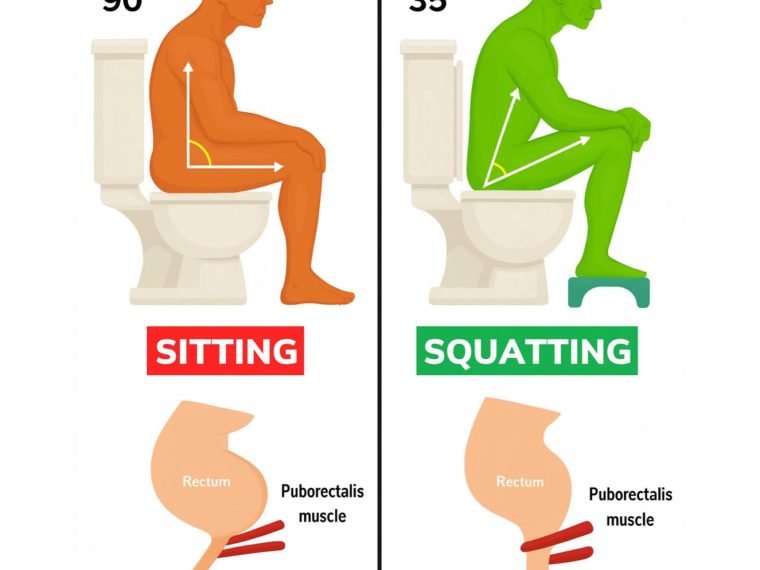These Are the Correct and Wrong Positions to Use the Toilet — Most People Do It Wrong Every Day 🚽
You might think there’s only one way to sit on the toilet — but surprisingly, the way you position yourself can make a huge difference to your health. Many people unknowingly strain their bodies each time they go, which can lead to problems like constipation, hemorrhoids, and even pelvic discomfort over time.
Let’s take a closer look at the right and wrong toilet positions, and how a simple change in posture can make your bathroom time easier, faster, and healthier!
🚫 The Wrong Way: Sitting at a 90° Angle
Most modern toilets are designed for comfort — but not for the way our bodies are built to eliminate waste.
When you sit upright with your thighs at a 90° angle to your torso (like sitting on a chair), the rectum and anus become partially kinked, making it harder for waste to pass smoothly.
This common sitting posture can cause:
- Straining and pushing too hard 💢
- Constipation and bloating
- Hemorrhoids (from repeated pressure)
- Incomplete bowel movements
💡 In short: sitting straight up is convenient, but not ideal for your body’s natural function.
✅ The Correct Way: The Squatting Position
Our bodies are naturally designed to eliminate waste in a squatting posture — the way humans did long before modern toilets existed.
When you squat, your colon aligns perfectly, straightening the rectum and relaxing the puborectalis muscle, allowing waste to pass quickly and completely.
How to do it right (even on a regular toilet):
- Sit on the toilet as usual.
- Place a small stool, footrest, or even a sturdy box (about 6–8 inches high) under your feet.
- Lean forward slightly with your elbows resting on your knees.
This gentle forward-leaning position mimics natural squatting and helps your body eliminate waste effortlessly.
💡 Tip: Your knees should be slightly higher than your hips.
🪑 The 3 Most Common Toilet Postures
Here’s a quick breakdown of the three main ways people sit — and what happens with each:
- Upright Sitting (90° angle) → Most common but least effective. Increases straining.
- Leaning Forward Slightly (around 60° angle) → Better, reduces pressure and helps flow.
- Squatting or Elevated Feet (35° angle) → Best position for smooth, complete elimination.
📊 Studies have shown that people in a squatting position spend less time on the toilet and experience fewer digestive problems.
🧘♀️ Why the Squat Position Is Healthier
- Prevents constipation: Reduces the need to push.
- Protects pelvic floor: Less strain on pelvic muscles.
- Helps prevent hemorrhoids: Lowers pressure in rectal veins.
- Promotes full evacuation: No residue or discomfort after.
- Improves colon health: Encourages natural movement of waste.
🚻 What If You Can’t Squat?
Not everyone can or wants to squat fully — and that’s okay! You can still improve your posture with small changes:
- Use a toilet stool (like a Squatty Potty).
- Place a rolled-up towel under your feet for elevation.
- Always lean forward slightly while keeping your back relaxed.
- Don’t hold your breath or force it — let gravity do the work.
💡 These small tweaks can make a big difference for your digestion and comfort.
⚠️ Extra Bathroom Tips for Better Health
🕐 Don’t sit too long: Prolonged sitting adds pressure and can cause hemorrhoids.
🚫 Avoid using your phone: It keeps you on the toilet longer than necessary.
💧 Stay hydrated: Water helps soften stool and prevent constipation.
🥦 Eat fiber-rich foods: Fruits, vegetables, and whole grains keep things moving.
🌿 Final Thoughts
Using the toilet seems simple — but doing it right can transform your digestive health. The key is raising your knees above your hips and leaning forward to mimic a natural squat.
It’s a small change, but the benefits are big: less straining, faster relief, and a happier, healthier gut.
So next time nature calls, remember — your posture matters more than you think! 🚽✨





